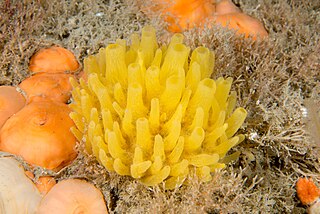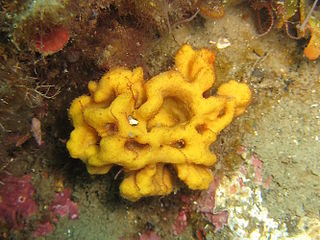
Juncaceae is a family of flowering plants, commonly known as the rush family. It consists of 8 genera and about 464 known species of slow-growing, rhizomatous, herbaceous monocotyledonous plants that may superficially resemble grasses and sedges. They often grow on infertile soils in a wide range of moisture conditions. The best-known and largest genus is Juncus. Most of the Juncus species grow exclusively in wetland habitats. A few rushes, such as Juncus bufonius are annuals, but most are perennials.

Geodia is a genus of sea sponge belonging to the family Geodiidae. It is the type genus of its taxonomic family.

Polymastia is a genus of sea sponges containing about 30 species. These are small to large encrusting or dome-shaped sponges with a smooth surface having many teat-shaped projections (papillae). In areas of strong wave action, this genus does not grow the teat structures, but instead grows in a corrugated form.

Axinella is a genus of sponges in the family Axinellidae first described in 1862 by Eduard Oscar Schmidt. Species of Axinella occur in the Indian and Pacific Oceans. Most of these sponges are smaller than 20 cm, and have a yellow or orange colour.

Pseudaneitea is a genus of air-breathing land slugs, terrestrial gastropod molluscs in the family Athoracophoridae, the leaf-veined slugs.
Stelletta is a genus of sea sponges belonging to the family Ancorinidae.

Clathria is a large genus of demosponges in the family Microcionidae.

Echinoclathria is a genus of demosponge in the family Microcionidae.
Higginsia is a genus of sea sponges belonging to the order Axinellida.

Callyspongia is a genus of demosponges in the family Callyspongiidae.

Cinachyrella is a genus of marine sponges in the family Tetillidae.

Aplysina is a genus of sea sponges in the order Verongiida. It was first authenticated and described by Giovanni Domenico Nardo in 1834.

Craniella is a genus of marine sponges in the family Tetillidae.

Mycale is a genus of demosponge with 240 recognised species in 11 subgenera. It has been a large genus with multiple subdivisions since it was first described in 1867.

Dicranocephalus is the sole genus of true bugs in the family Stenocephalidae. There are about 30 described species in Dicranocephalus.

Discodermia is a genus of deep-water sea sponge.

Antho is a genus of sponges belonging to the family Microcionidae. The genus has a cosmopolitan distribution and is known from virtually all parts of the global ocean. There are 62 species in five subgenera.
Fibulia is a genus of sponges belonging to the family Dendoricellidae. The species of this genus are found in Southern South Hemisphere.

Phorbas is a genus of demosponges belonging to the family Hymedesmiidae.
Hemiasterella is a genus of sponges belonging to the family Hemiasterellidae.
















